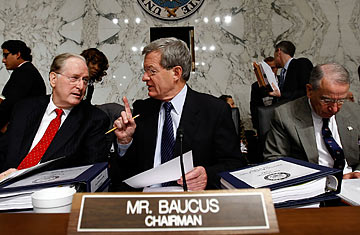
Senator Jay Rockefeller talks with Senate Finance Committee chairman Max Baucus before the markup of the committee's health-reform bill on Sept. 29, 2009
When West Virginia Senator Jay Rockefeller gave his closing argument on Sept. 29 to the Senate Finance Committee in support of his amendment to create a new government-run health-insurance plan, he sounded amply frustrated. Describing the people of his state, he said they were "out in the cold" and "helpless" against faceless insurance bureaucrats who treat them unfairly. A public health-insurance plan, he said, would create competition for private insurers and could put patients, not profits, first. "These are people," he said, banging the table more than once. "Eleven-year-old kids. These are families, and we have to respect them. And you respect them by giving them a choice."
Rockefeller's frustration was apparent not just because his constituents badly need health-care reform — 16% of West Virginians are uninsured — but also because his amendment to the Senate Finance Committee's current health-reform bill was doomed to fail. It was voted down, 15 to 8, with five Democrats — including committee chairman Max Baucus — joining all 10 Republicans on the committee in opposition. Baucus, who agrees with Rockefeller that a public option would save the Federal Government money and lower costs for consumers, nonetheless believes that a bill with such an option will not garner enough support to overcome the threat of a filibuster and make it for a vote on the Senate floor; almost all Republicans and many moderate Democrats believe that such a plan would force private insurance companies out of business and eventually lead to a single-payer system, with the government as the only viable entity selling insurance. "My first job is to get this bill across the finish line," Baucus said during the committee's fifth day of debate. "Rome was not built in a day."
But despite evidence that Baucus is right — currently the Senate does not have 60 public-option supporters — the public option may not be dead yet. A subsequent public-option amendment offered by New York Senator Charles Schumer called for negotiated reimbursement rates — in contrast to Rockefeller's amendment, which would have pegged reimbursements to Medicare rates for the first two years — and as a result garnered support from two Democrats whose position was not previously known, Senators Bill Nelson and Thomas Carper. It still failed, 13 to 10, but the new tally indicated that there may be some room to negotiate with wary Democrats on the structure of a public option. The Senate Finance Committee is one of five in Congress with jurisdiction over health care; bills from the Senate Health, Education, Labor and Pensions Committee and three committees in the House do contain public options. There is also a chance, however slight, that 60 Senators would vote to end a filibuster, even if some of them peeled away when it came time to vote on the actual legislation, which needs only a 51-vote majority to pass.
But the most likely way that a public option could end up part of the finished product is as a backup plan. Maine Republican Olympia Snowe, who has been publicly courted by the White House as the most probable member of her party who might vote for reform, has offered an amendment that calls for a public option to kick in down the line only if private insurers don't do enough to offer affordable health-insurance choices. According to the text of her amendment, a public option would be offered if at least two private insurers didn't offer plans that met affordability requirements for at least 95% of residents in a given state. Affordability is defined as premiums costing no more than 13% of adjusted gross income for those earning more than 300% of the federal poverty line (or around $66,000 for a family of four); for those earning less, the out-of-pocket maximum ranges down to 3% of income.
Much to the dismay of liberal critics and some health-policy experts, this so-called trigger plan would be offered state by state rather than on a nationwide basis. If insurers were determined not to offer an affordable choice in a given state, they would still have a second chance to meet affordability standards before the public option would kick in. Snowe, in her amendment, refers to the public option as a "safety net" plan, without specifying whether such a plan would have to meet the minimum standards for adequate insurance coverage defined elsewhere in health-reform legislation. She also does not specify what entity would evaluate affordability or run her public option, described only as a "nonprofit government corporation." Snowe could bring the amendment before the committee later this week.
In the House, where many conservative Blue Dog Democrats have said they will not vote for a bill that contains a public option, wrangling over the proposal is not quite so public. House Speaker Nancy Pelosi is in the process of merging bills from the three committees there with jurisdiction over health care, and the design of the public plan is one of the sticking points. The original version of the House bill contained a public option that would have set its reimbursement rates above, but still tied to, Medicare rates. But an amendment that passed in the House Energy Committee would have a public option with negotiated rates, roughly equivalent to Schumer's supposedly "level playing field" approach. According to a Democratic leadership aide in the House, the Congressional Budget Office, which determines the cost of legislation, has told Pelosi that the Medicare-pegged rates would lead to $110 billion in savings over 10 years, while negotiated rates would save only about $25 billion. Pelosi, who is trying to whittle the House bill down from its $1.1 trillion price tag closer to the $900 billion that both Baucus and Obama are targeting, is hoping to use these CBO estimates to convince Democrats who oppose a public option to come on board.
